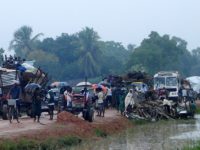Monsoon Woes of Himachal Pradesh: A Man-Made Natural Disaster

Landslides and the occasional floods are quite common occurrences in Himachal Pradesh during the monsoon. However, in recent years there has been a drastic increase in both the frequency and the intensity of these events. 2023 has been one of the worst years on record for the state. Since the onset of the monsoon in June the state has been caught in a never-ending cycle of landslides, cloudbursts and flash floods. The state has already recorded 131 landslides and 60 flash floods. Cloudbursts have increased by 121% while landslides and flash floods have doubled compared to last year. 348 deaths have been reported as a direct result of these disasters.
According to the Himachal Pradesh State Disaster Management Plan, the increase in the severity and frequency of these natural calamities is a result of global climate change. However, one is forced to wonder the role the Government has played in the worsening of the situation in Himachal during the monsoons. Environmentalists agree that climate change is responsible for the erratic monsoon but in the same breath highlight the government’s pro-industry policies as an important factor contributing to the increased frequency and severity of incidents of landslides and flash floods.
The increase in the natural disasters in the state can be traced to the liberalisation of the economy in the 1990s. The then Congress-led central government implemented major fiscal reforms which forced the mountain state to be responsible for its own fiscal management. It did not bother to take into account the ecosystem nor the environmental impact these policies would put on the state and its citizens. It is common knowledge in the scientific community that the Himalayas are still in its growing phase and are not yet geologically stable. However, due to the Centre’s change in fiscal policies, the state government dove head first in its development projects, disregarding the unique geological and ecological aspects of the state.
The state’s development model marked by rapid industrialization which was introduced by Congress continued unabated irrespective of which party was in power in the Centre or the state. The rapid exploitation of natural resources like forests and water, an increase in tourism and cement production became a major focus for their development model. These “development projects” were just money-making opportunities for the government backed by big business. As a matter of fact, the 2015 Landslide Hazard Risk Assessment report submitted to the state’s Disaster Management Cell stated that all the 77 blocks consisting over 18,577 villages were deemed at risk of landslides. However, the Government, least bothered about the long term welfare of the working class, has continued approving construction projects ranging from highways, cement factories to hydropower plants backed by big business in the name of economic development of the state.
The hydropower industry is central to the state’s development model. The government has waged a planned campaign of promoting Hydropower as a clean and renewable energy source with minimum environmental impact to gain public support for these projects. Since 2000 there has been a major shift in policy regarding hydropower projects with large projects getting easy finance and approval. Currently there are 168 hydropower projects in operation, which is set to increase to 1088 by 2030. The mountains are not equipped for such large scale projects. The technology involved in the construction of the projects has not only reduced rivers to mere streams but also often destabilised the region making it vulnerable to massive landslides.
Rapid industrialization has led to an increasing demand for widening of roads and construction of new roadways to facilitate the transfer of goods from the hills to the market. The widening of roads or constructing of new roads are approved without proper geological and engineering assessment making these mountain regions prone to landslides and sometimes collapse of entire hill regions. 4,312 km of state roads have already been approved for the national highway expansion and work has already started on the existing highways. The irresponsible and unscientific dumping of muck and debris from the road expansion sites and hydropower project sites has resulted in exacerbating the effects of the flash floods and cloudbursts by many folds. The river basins of the Parvati, Beas and Sutlej are proof of this.
In the multiple flash floods and landslides of 2023 more than 2,220 houses were destroyed, 10,000 houses were partially destroyed with 300 shops rendered unusable. It also took its toll on the livestock killing nearly 10,000 poultry birds and 6000 cattle. The population affected by such tragedies are mostly working-class people who have lost everything—their livelihood, their homes and in some cases their loved ones. Their lives are upended because of the greed of big industry who are only interested in their profit. The Government is not interested in changing policies or modifying their development model as it would affect their bottom line. Neither Congress or BJP is interested in the long term welfare of the people of the mountains. Scientists and Engineers who don’t toe the line are removed from their roles in various advisory committees. Any dissenting voices in the scientific community are silenced and tagged as anti-development forces or urban naxals.
The Centre and the state government work in tandem to manipulate reports and undermine existing environment policies. Whenever environmentalists and climate change experts try to raise awareness about India’s rapid loss of forest cover, the Government is quick to quash such concerns with its manipulated reports. The analytical study conducted by the State Center on Climate Change reports that there has been an increase in forest cover by 25% from 1991 to 2015, but the State fails to mention that the deep forest cover has actually shrunk to less than 10%. It is the deep forest cover which actually is instrumental in mitigating the magnitude and frequency of landslides. The parameters of these studies are worded ambiguously that does not differentiate between forest/green cover and deep forest cover. It is the deep forests which are actually being destroyed to implement these destructive projects. A pro-industry government is never going to enact policies that would make it difficult for the private industries to operate.
How can the government justify the indiscriminate approval of hydropower plant projects, construction projects, increase in subsidy for cash crops as pro-development when every year 100s of people lose their house, property, livelihoods and lives! The Chief Minister of Himachal Pradesh, Sukhvinder Singh Sukhu, has announced that the state has suffered an estimated 100 billion rupees or 1.2 billion dollars loss due to the natural disasters this monsoon. More than 250 roads are still blocked. Parts of the Shimla and Manali highway have been washed away or severely damaged. Entire villages have been washed away in the Kinnaur valley. Is this what development is supposed to look like?
It is high time that we demand better and long term welfare for the local community. We demand that the local people (the actual major stakeholders) be part of these policy making boards and be approving of projects. Sufficient time should be given to the scientific community to conduct the necessary geological and ecological survey before deciding the fate of any projects. These surveys need to be impartial and not beholden to corporate interests. Most importantly the local communities need to be empowered to be custodians of important necessary common assets of the community like small bridges, culverts, schools and other social infrastructure. Additionally, we demand that the government should first improve the quality of the existing infrastructure to withstand flash floods and landslides, instead of undertaking rapid expansion projects.
Climate change is a reality and such natural disasters are already the new normal. However, this doesn’t mean we should increase the magnitude of its effects through irresponsible planning. It is in the interest of the working class to demand better environmental policies and put an end to making deals with private industries behind closed doors. We deserve better. We deserve not to live in fear every monsoon waiting for another devastating landslide or flash flood which can leave us homeless and take away our loved ones. We deserve a stable and secure life with better living conditions. We demand that the government stop approving hastily planned projects under the guise of economic development of the region. It can only happen when the real stakeholders, the local community, is a part of the decision making process and all relevant scientific survey information is disclosed to the public.






